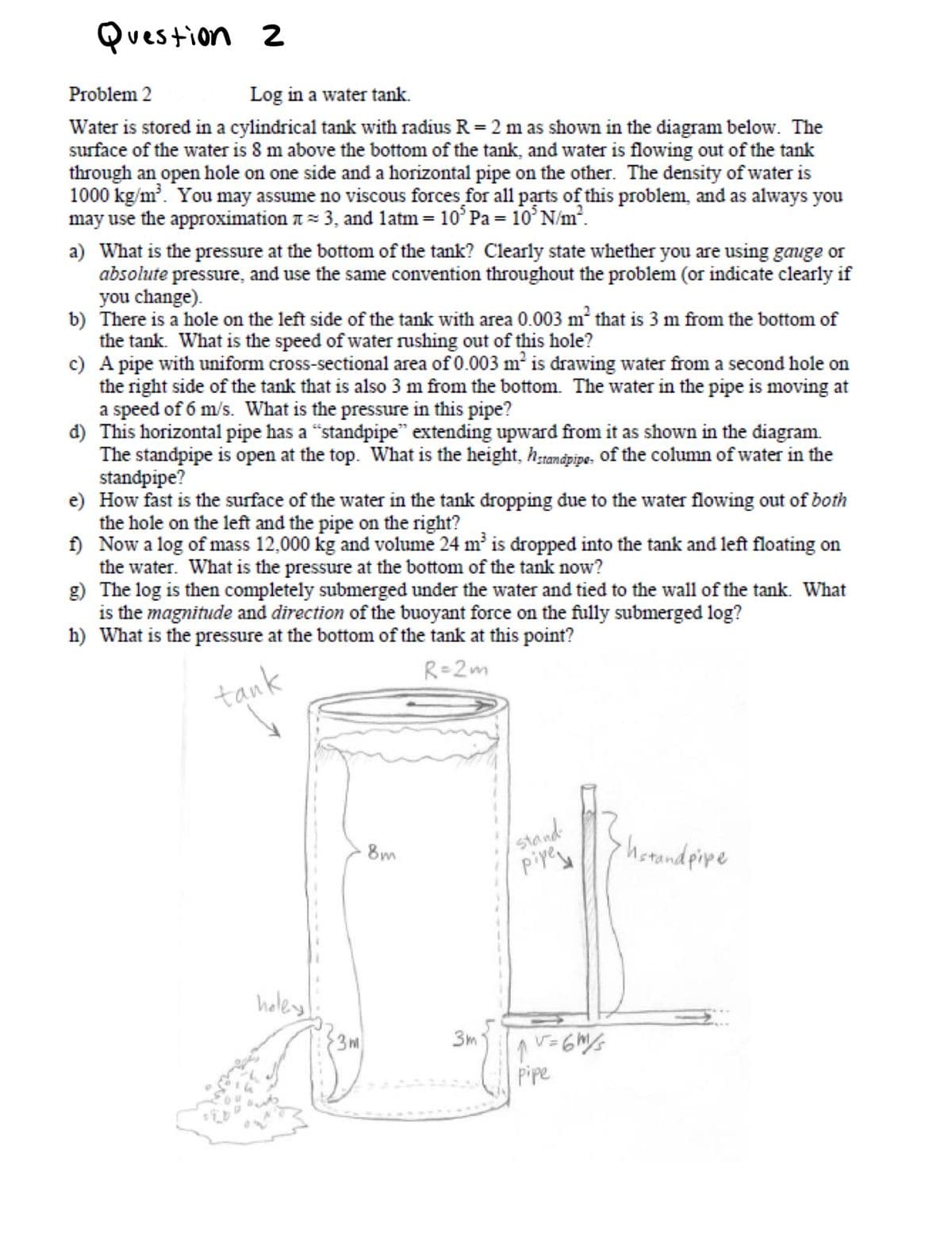Water is stored in a cylindrical tank with radius R=2m as shown in the diagram below. The surface of the water is 8 m above the bottom of the tank, and water is flowing out of the tank through an open hole on one side and a horizontal pipe on the other. The density of water is 1000 kg/m. You may assume no viscous forces for all parts of this problem, and as always you may use the approximation a= 3, and latm = 10° Pa = 10ʻ N/m?. a) What is the pressure at the bottom of the tank? Clearly state whether you are using gauge or absolute pressure, and use the same convention throughout the problem (or indicate clearly if you change). b) There is a hole on the left side of the tank with area 0.003 m² that is 3 m from the bottom of the tank. What is the speed of water rushing out of this hole? c) A pipe with uniform cross-sectional area of 0.003 m2 is drawing water from a second hole on the right side of the tank that is also 3 m from the bottom. The water in the pipe is moving at a speed of 6 m/s. What is the pressure in this pipe?
Water is stored in a cylindrical tank with radius R=2m as shown in the diagram below. The surface of the water is 8 m above the bottom of the tank, and water is flowing out of the tank through an open hole on one side and a horizontal pipe on the other. The density of water is 1000 kg/m. You may assume no viscous forces for all parts of this problem, and as always you may use the approximation a= 3, and latm = 10° Pa = 10ʻ N/m?. a) What is the pressure at the bottom of the tank? Clearly state whether you are using gauge or absolute pressure, and use the same convention throughout the problem (or indicate clearly if you change). b) There is a hole on the left side of the tank with area 0.003 m² that is 3 m from the bottom of the tank. What is the speed of water rushing out of this hole? c) A pipe with uniform cross-sectional area of 0.003 m2 is drawing water from a second hole on the right side of the tank that is also 3 m from the bottom. The water in the pipe is moving at a speed of 6 m/s. What is the pressure in this pipe?
Engineering Fundamentals: An Introduction to Engineering (MindTap Course List)
5th Edition
ISBN:9781305084766
Author:Saeed Moaveni
Publisher:Saeed Moaveni
Chapter10: Force And Force-related Variables In Engineering
Section: Chapter Questions
Problem 3P: An astronaut has a mass of 68 kg. What is the weight of the astronaut on Earth at sea level? What...
Related questions
Question
100%
2

Transcribed Image Text:Question 2
Problem 2
Log in a water tank.
Water is stored in a cylindrical tank with radius R = 2 m as shown in the diagram below. The
surface of the water is 8 m above the bottom of the tank, and water is flowing out of the tank
through an open hole on one side and a horizontal pipe on the other. The density of water is
1000 kg/m. You may assume no viscous forces for all parts of this problem, and as always you
may use the approximation t = 3, and latm= 10° Pa = 10° N/m².
a) What is the pressure at the bottom of the tank? Clearly state whether you are using gauge or
absolute pressure, and use the same convention throughout the problem (or indicate clearly if
you change).
b) There is a hole on the left side of the tank with area 0.003 m² that is 3 m from the bottom of
the tank. What is the speed of water rushing out of this hole?
c) A pipe with uniform cross-sectional area of 0.003 m is drawing water from a second hole on
the right side of the tank that is also 3 m from the bottom. The water in the pipe is moving at
a speed of 6 m/s. What is the pressure in this pipe?
đ) This horizontal pipe has a “standpipe" extending upward from it as shown in the diagram.
The standpipe is open at the top. What is the height, h;tandpipe. Of the column of water in the
standpipe?
e) How fast is the surface of the water in the tank dropping due to the water flowing out of both
the hole on the left and the pipe on the right?
f) Now a log of mass 12,000 kg and volume 24 m is dropped into the tank and left floating on
the water. What is the pressure at the bottom of the tank now?
g) The log is then completely submerged under the water and tied to the wall of the tank. What
is the magnitude and direction of the buoyant force on the fully submerged log?
h) What is the pressure at the bottom of the tank at this point?
R=2m
tạnk
stand
piyese
8m
hotandpipe
heley
3m
3m
Pipe
Expert Solution
This question has been solved!
Explore an expertly crafted, step-by-step solution for a thorough understanding of key concepts.
This is a popular solution!
Trending now
This is a popular solution!
Step by step
Solved in 6 steps

Knowledge Booster
Learn more about
Need a deep-dive on the concept behind this application? Look no further. Learn more about this topic, civil-engineering and related others by exploring similar questions and additional content below.Recommended textbooks for you

Engineering Fundamentals: An Introduction to Engi…
Civil Engineering
ISBN:
9781305084766
Author:
Saeed Moaveni
Publisher:
Cengage Learning

Engineering Fundamentals: An Introduction to Engi…
Civil Engineering
ISBN:
9781305084766
Author:
Saeed Moaveni
Publisher:
Cengage Learning